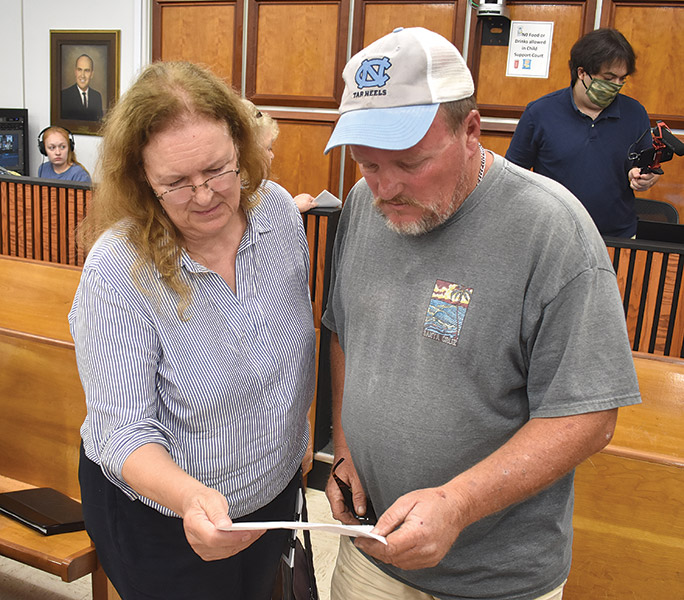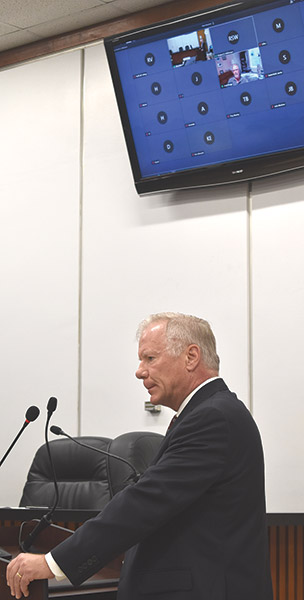‘People in my district live in it’
Some tough questions posed after TDEC presentation on status of Bull Run closure
The Tennessee Department of Environment and Conservation presented an update to the Anderson County Intragovernmental Committee regarding the closure of Bull Run Steam Plant Monday night.
Working with the Tennessee Valley Authority, TDEC is overseeing the process, which includes a wide range of testing procedures, analysis of data, and formulating a plan for cleanup and disposal/storage of “coal combustion residue (CCR)” — coal ash.
TVA has been tasked with developing an environmental investigation plan that includes testing for soil, surface water, and groundwater contamination (and extent of any contamination), and a plan for cleanup.
Monday’s meeting addressed those areas.
“Once the plan is OK’d by TDEC, it goes out to the public for comments,” said Pat Flood, senior advisor with TDEC’s Bureau of Environment.
Flood said it could be as late as August 2023 before a final plan is ready for public comment and input.
Flood said the “field investigations” are complete and lab analyses are underway.
The plan outlined Monday included lab analyses in numerous areas.
And those areas of testing don’t stop at soil, water, and wildlife — Bull Run has a, “very complex geology,” TDEC’s Robert Wilkinson said.
Wilkinson narrated the Power Point presentation Monday night.
Bull Run Steam Plant is located in proximity to two fault lines, and g with the karst topography of the location makes for “unique geophysichs.”
The presentation gave an update on the progress so far.
But for Anderson County Commissioner Tracy Wandell there was something missing.
Representing District 1 — the Claxton Community where Bull Run is located — Wandell said, “Looking at your web site I see the graphs, the curves, the pie charts … But the dates are gone. The time lines seem to have disappeared.”
Wandell said the decision to close Bull Run was signed on Aug. 6, 2016, and noted a lot of work was has been done.
“It made me feel good when TDEC got involved (with the closure of Bull Run), but six years later I’m a little perturbed,” he said.
“TDEC is getting the data tested and TVA keeps kicking the ball down the field. I need timelines,” Wandell said.
“I represent the people in that district, Chuck Fitts (who was in attendance Monday night) represents those people. Coal Ash is still stitting there and the people in my district are living in it. TDEC knows it. TVA knows it. I need timelines.”
Wandell said he “respected” the fact that the COVID pandemic played a part in the original testing for contaminates and schedule for closure of the plant.
Claxton resident Sharon Todd echoed Wandell’s feelings.
“I’m concerned about the time line,” she said. “I’m afraid 2023 is going to come along and TVA is going to say, ‘We’re out of time. We’re out the door,’ and there is going to a mess left behind.”
Another Claxton resident, Jason Williams, took exception to some of the testing.
During the presentation by TDEC samples of fish (bottom feeders such as catfish and “mid-stream” swimmers) and mayflies.
“Are you testing for uranium and thorium in the coal ash?” William asked. “If you’re not, you should be.”
“We were told Bull Run Creek was safe,” he said. “And then you say today that there’s selenium and arsenic?”
The TDEC presentation noted that Bull Run Creek has “exceedances for CCR constituents” in selenium, arsenic, berylilium, lead, and nickel.
Other surface water tested was Worthington Branch (exceedances in selenium, arsenic, barium, berylilium, mercury, and nickel) and the Clinch Rover (arsenic and copper — adjacent to the pant and downstream).
He asked if there have been tests conducted to check for radium.
“The fish and mayflies are fine. They’re living. But have you tested the geese or the ducks?” he asked.
“The geese and the duck are dead. So are most of the workers,” he said. “You need to test the right stuff and do it in a timely manner.
“Why are you not posting that it’s a danger? Why are you not cleaning it up? Test it and do the right thing,” he said.



